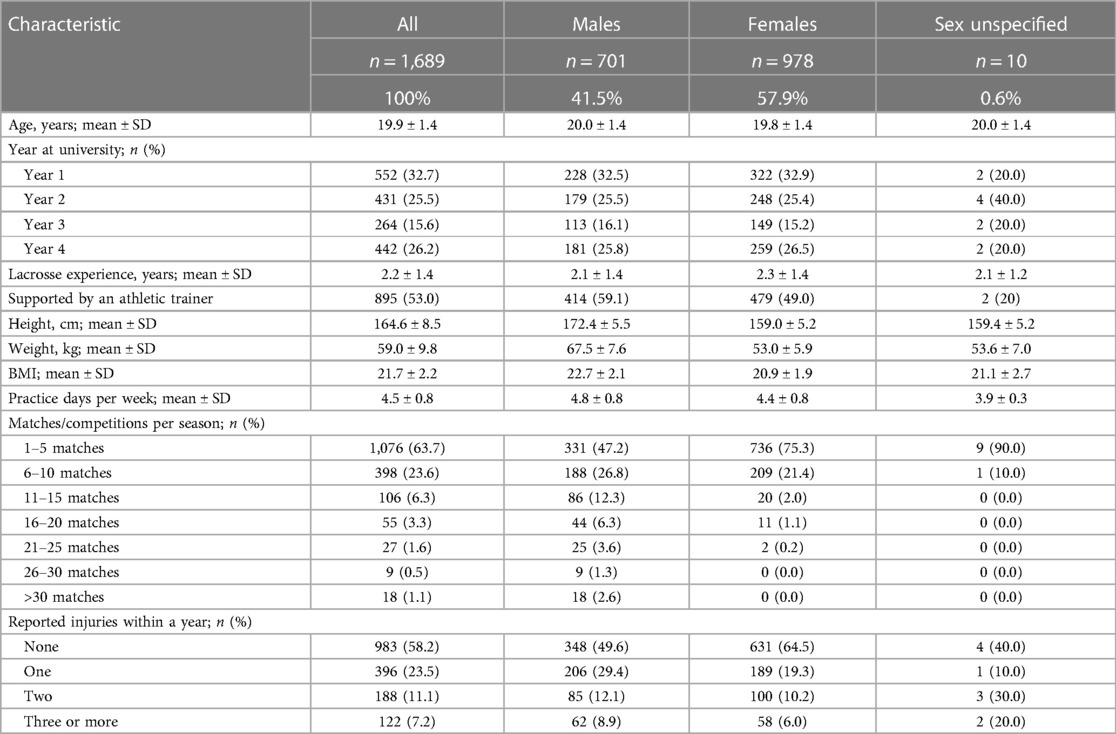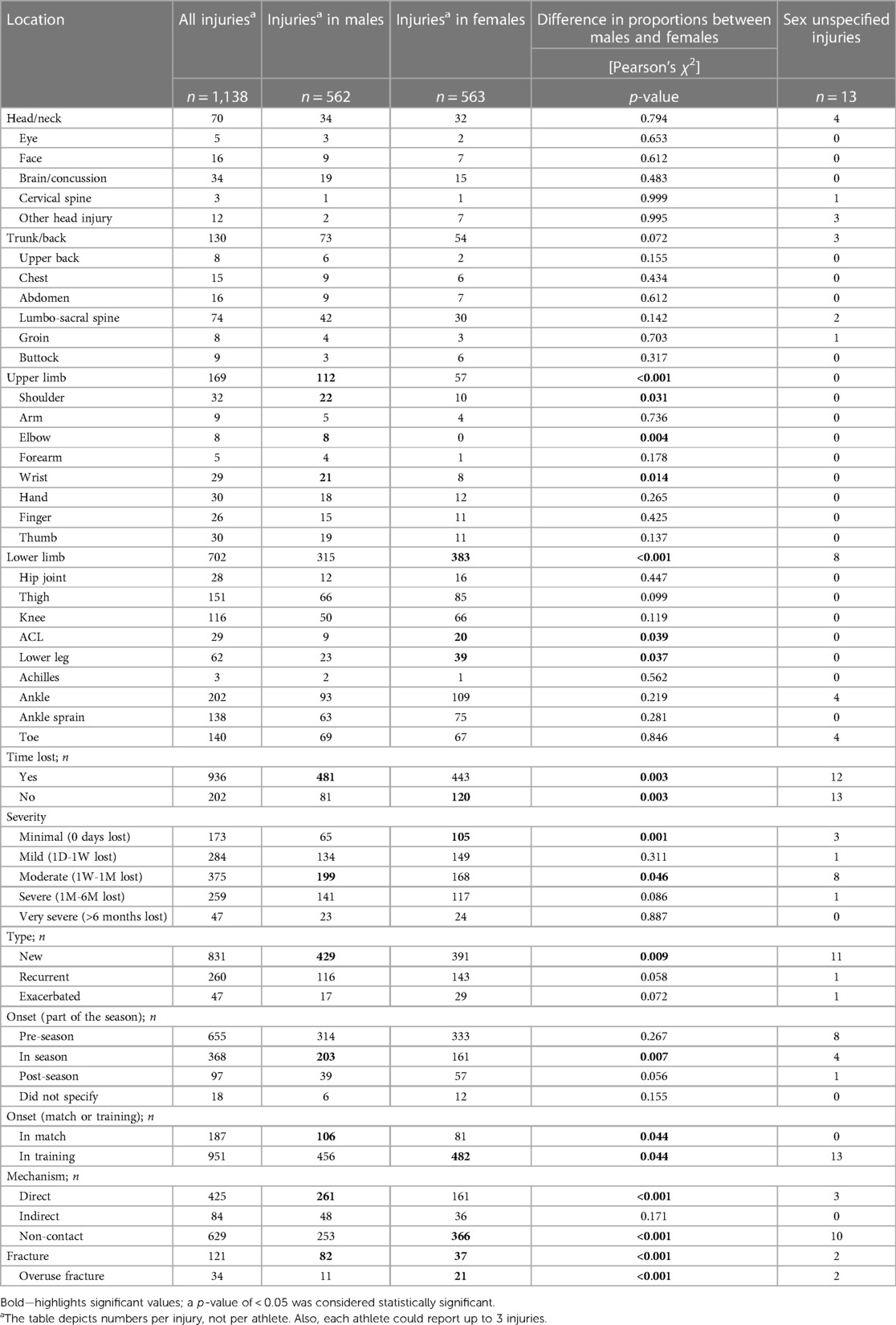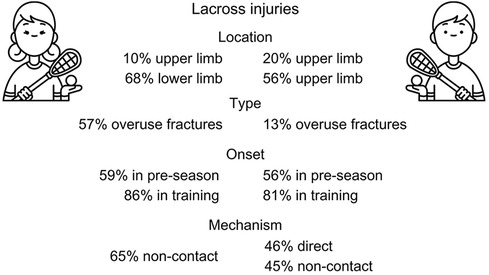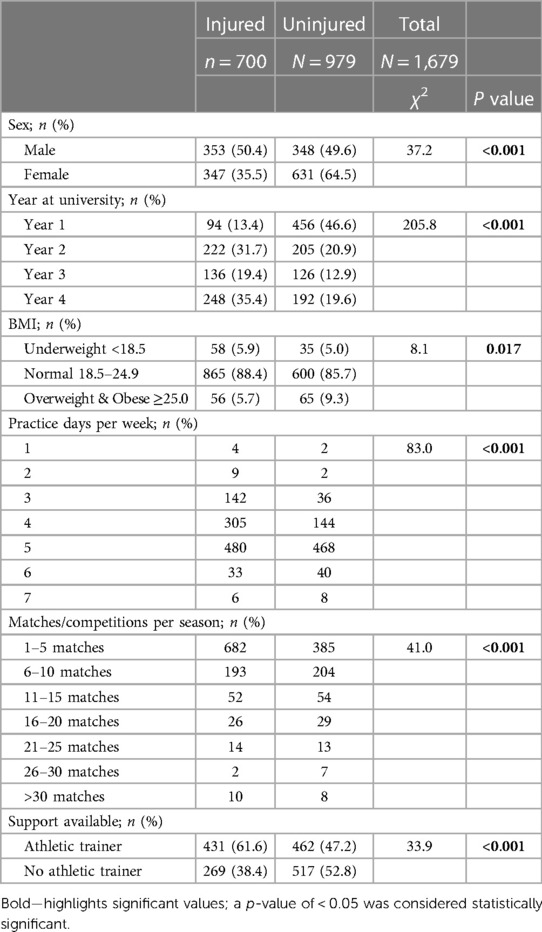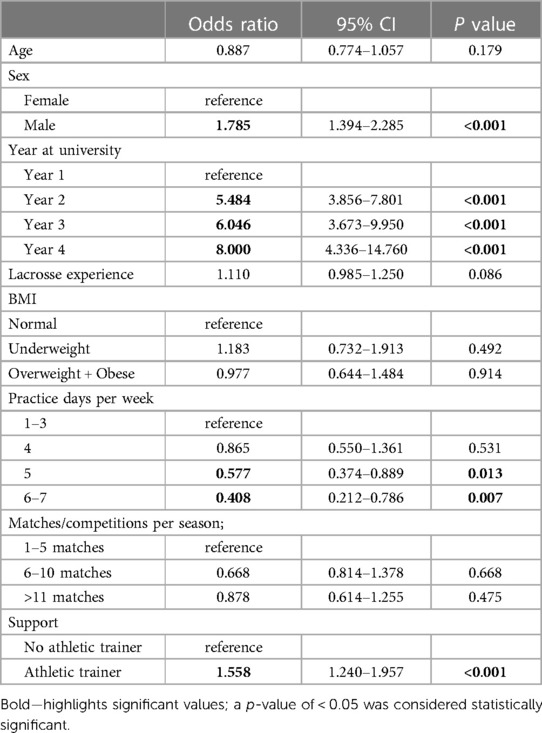- Institute for Integrated Sports Medicine, School of Medicine, Keio University, Tokyo, Japan
Context: Sports injuries have a substantial impact on athletes' performance and health. To reduce the risk of an injury occurring, the prevalence, localization, and severity need to be established.
Objective: To examine the prevalence of sports injuries in collegiate lacrosse athletes.
Design: Descriptive epidemiological study using online survey design.
Setting: Japanese universities associated with UNIVAS.
Participants: A total of 1,689 Japanese collegiate lacrosse athletes, 978 females and 701 males.
Main outcome measures: Athletes were surveyed on the injuries within the previous year, their severity, localization, and onset characteristics. The support of an athletic trainer and its association with the odds of sustaining an injury was assessed. Factors related to injuries were explored.
Results: One-year prevalence of injuries was 42%. Male sex, higher year at the university, and support from an athletic trainer were identified as factors related to higher odds of sustaining an injury and practicing at least 5 days per week was associated with lower odds of sustaining an injury.
Conclusions: Male sex athletes, and athletes at the higher year at university are especially at risk of sustaining a lacrosse injury. The aspects of training (e.g., frequency, volume) should be investigated across the athlete development process to address these findings. Further investigation is needed to determine the extent to which the support of athletic trainers affects both the frequency and severity of injuries in lacrosse athletes.
Key points:
- Japanese collegiate lacrosse athletes reported 42% 1-year-prevalence of sports injuries, with 82.3% of the injuries causing time lost from training and competition.
- Training parameters (e.g., frequency, volume) should be assessed in the light of long-term athlete development.
- Support from athletic trainers should be optimized to assist with reducing the number and severity of injuries both in short- and long-term.
Introduction
Lacrosse is a contact sport involving considerable amount of running, changing direction, and throwing. The use of sticks to propel the ball and the dynamic and unpredictable nature of this sport produces a unique context for injuries' occurrence. Injuries in lacrosse are frequent and require time off training (1). A range of protective measures, including compulsory and optional use of protective equipment, has been introduced to reduce the risks but with limited success especially for concussions (1).
Lacrosse is contested slightly differently in males and females, including varying rules on protective equipment which may influence injury patterns (2). The most frequent lacrosse-related injuries in men include lower limb and upper limb, and lower limb and head/neck in women (1, 3). It has been previously reported that lacrosse female athletes have a higher risk of ACL (anterior cruciate ligament) injuries due to their upright posture and extended knees while they play (4). Females are also at higher risk of sustaining a head, face, and eye injury than males in lacrosse (5). Moreover, the frequency of injuries has been reported to increase from youth to junior to senior lacrosse levels indicating the age as a contributing factor (6). All these data come from lacrosse athletes in the US (United States of America), therefore perspectives from other countries are desperately needed to establish which injury patterns arise from the sport itself and which ones have a cultural context. This will allow future injury-prevention strategies to target cultural and sports-specific contributions explicitly, likely increasing their effectiveness.
The purpose of the current study was to establish the 1-year prevalence of, and the factors related to lacrosse-related injuries in Japanese collegiate athletes.
Methods
Research design
In this observational study with a cross-sectional design, data was collected using a web-based survey from June to October 2022. The study received approval from Keio University's Ethics Committee (approval number: 20211158). The study was conducted in compliance with the Declaration of Helsinki's principles and reported as per the STROBE-SIIS consensus statement and CROSS consensus statement (7–9).
Participant recruitment
Potential participants were invited from the lacrosse teams associated with UNIVAS (Japan Association for University Athletics and Sport) and located across Japan. Athletes were then asked to read the study's information sheet and consented to participating in the survey. The sample size was calculated at 372 participants using expected proportion in the population from Japanese collegiate handball players (10) and the formula devised by Charan and Biswas (11).
Survey
The survey was hosted on a website specifically created for this study (https://enquete.cc/q/BC2XC8A8). The anonymous survey asked about athlete characteristics, lacrosse experience, and injuries sustained while playing lacrosse in the previous year (retrospective design). Follow-up questions about the three most serious injuries included details on the injury location, severity, type, time of onset, mechanism, time lost from sports participation, and diagnosis. Questions were adapted from the Japanese Society of Clinical Sports Medicine and Japanese Society for Athletic Training consensus document and modified to suit collegiate athletes (12).
Injury severity was determined based on the amount of time lost from training/competition and classified using recent guidelines (8, 13) and consisted of: minimal—0 days missed; mild—1 day–1 week lost; moderate—1 week–1 month lost; severe—1 month–6 months lost, very severe—more than 6 months lost. The injury type was classified as new, recurrent (the injury disappeared before but occurred again), or exacerbated (symptoms worsened), while the injury mechanism was classified as direct (direct application of the force), indirect (indirect application of the force), or non-contact (12).
Statistical analysis
The SPSS software [IBM Corp. Released 2021. IBM SPSS Statistics for Macintosh, Version 28.0. Armonk, NY: IBM Corp] was used for statistical analysis. The study gathered both qualitative and quantitative information. Continuous data was summarized using mean and standard deviation while discrete data was summarized by calculating counts and percentages. A p-value of less than 0.05 was considered to be statistically significant.
To calculate the one-year period prevalence, the number of injured athletes was divided by the total number of athletes and multiplied by 100%. We used the chi-square test (Pearson's chi-square, Fisher's exact test, or Fisher's exact test with Monte Carlo estimates, as appropriate) to compare the differences in injury characteristics such as location, severity, type, onset, mechanism, and time lost between females and males.
To assess the factors associated with injury occurrence, we utilized regression models that included participant demographics and sports participation. Multivariable logistic regression was used to estimate odds ratios (ORs) with 95% confidence intervals for each outcome variable.
Results
Participants
Characteristics of lacrosse athletes are presented in Table 1. Out of 1,689 athletes who responded to the survey, 42% reported at least one injury within the previous year, and 7% reported three or more injuries.
Injuries
Lacrosse athletes (n = 1,689) sustained 1,138 injuries, with 82.3% of the injuries causing time lost from training and/or competition, 1 in 4 injuries requiring more than a month off and 4% requiring more than 6 months. Characteristics of injuries are presented in Table 2.
Among Japanese collegiate lacrosse athletes, males and females reported somewhat different patterns of injuries. A summary of the differences is presented in Figure 1. In females, 68% of injuries were to the lower limbs with 5% of these being ACL injuries, and only 10% being upper limb injuries. Fifty-seven percent of all fractures in this group were overuse fractures (vs. 13% in males). Most injuries in females happened in pre-season (59%), in training (86%), and due to a non-contact mechanism (65%). Males reported 20% of upper limb injuries and 56% of lower limb injuries. The majority of their injuries happened in training (81%) with 56% occurring in pre-season and 36% in season, due to direct (46%) or non-contact (45%) mechanisms.
Females and males differed in the proportions of some injury characteristics. Females had a significantly higher proportion of lower limb injuries, including ACL injuries and fractures but a lower proportion of injuries that required time off training or matches than males. A higher proportion of their injuries occurred in training and due to non-contact mechanisms. Compared to females, a higher proportion of males reported upper limb injuries, time lost due to an injury, new injuries, and injuries of moderate (1 week–1 month) severity, occurring in season, in match, and resulting from a direct mechanism. Half of the males and one-third of the females reported injury within the previous year but both groups had similar proportions of severe and very severe injuries (27%).
Injuries with severe impact included ACL injuries, fractures, and concussions. Out of 29 ACL injuries reported, 22 were sustained in pre-season, 4 in season, and 3 post-season, 21 ACL injuries occurred in training and 8 in match. The proportions of ACL injuries were similar between the athletes who had athletic trainers (n = 13) and not (n = 16). All ACL injuries were reported as severe or very severe, incurring mostly more than 6 months lost from training and competition. The severity distribution of ACL injuries was not different between females and males.
More than half (n = 70/121) of all fractures were severe (1–6 months lost) and one-fourth (n = 29/121) were moderate (1 week—1 month lost). Males had a significantly higher number of all fractures (82 fractures in males vs. 37 in females) but females had a higher proportion of overuse fractures (21 overuse fractures in females vs. 11 in males). More than half of overuse fractures (n = 19/34) were severe (1–6 months lost) and 7 were moderate (1 week to 1 month lost). Forty-one of the athletes who experienced fractures reported having an athletic trainer but 80 did not.
Half (n = 17/34) of concussions were of moderate severity (1 week to 1 month lost) but 7 were severe (1–6 months lost) and 9 were mild (1 day to 1 week lost). The frequency and severity proportions of concussions were not different between males and females.
Injured vs. uninjured athletes
Differences in characteristics between injured and uninjured athletes are presented in Table 3. Significant differences in proportions between injured and uninjured athletes were found for sex, year at university, BMI, practice days per week, matches per season, and support from an athletic trainer. Additionally, group difference was found in age (injured 20.3 (±1.3) vs. uninjured 19.6 (±1.4); t-test, p < .003) and sports experience (injured 2.5 (±1.4) vs. uninjured 1.9 (±1.3); t-test, p < .004).
Factors related to an injury
Factors related to sustaining an injury are presented in Table 4. Male sex, higher years at the university, and support from an athletic trainer were identified as factors related with higher odds of sustaining an injury. Training five or more days per week was associated with lower odds of sustaining an injury.
Additionally, mean time lost due to an injury (±SD) differed significantly between the athletes. Athletes (n = 716) who had the support of an athletic trainer missed 40.8 (±1.9) days, and athletes (n = 422) who did not, missed 33.6 (±2.3) days (t-test, p-value = 0.018).
Discussion
The impact of injuries in Japanese collegiate lacrosse athletes is high for both females and males. Male sex, higher years at the university, and support from an athletic trainer were identified as factors related to higher odds of sustaining an injury. Training five, or more, days per week was associated with lower odds of sustaining an injury. This study complements the available reports on lacrosse injuries mostly in the American collegiate and high school populations and is a valuable contribution to the global lacrosse literature.
Impact of injuries
The impact of the injuries in Japanese collegiate lacrosse athletes is high for both females and males. This is evident with severe and very severe injuries reported often for both groups with 1 in 4 injuries requiring more than a month off training and competition. Also, sports injuries with well-documented detrimental impacts are prevalent in the athletes in this study. Injuries to ACL reported by Japanese athletes appear to be more frequent (30 per year) than reported in the US collegiate lacrosse athletes (11–12 per year) (4, 14). These injuries also affected Japanese female athletes more (70% vs. 54%–56%) than previously reported in the comparable US population (4, 14). Overuse fractures reported in this study (3.7% of all injuries in females, 1.9% in males) were higher than reported for American high school athletes (2.8% for females, 1.5% for males) (15) but the fact that the proportion was higher in females seems to agree with previous reports for high school and collegiate US athletes (15, 16).
Head, brain, face, and eye injuries are of concern in lacrosse due to their potentially catastrophic consequences. In this study, concussions were 49% of all head injuries and were similarly frequent between males and females, whereas previous studies reported males sustain concussions more often than females (80% vs. 40%) (5). All concussions reported in this study required time off training which shows their detrimental impact. Eye injuries reported in this study were infrequent but considering the relatively small sample size and the self-reported nature of the study design, no conclusions can be made.
Factors related to sustaining an injury
Male sex was a factor related to higher odds of sustaining injuries. Males reported more injuries and a higher proportion of their injuries was moderate in severity than females. This may be related to the more aggressive nature of the game for males than females, even though males use more protective equipment (2). The fact that male athletes' lacrosse injuries are at higher proportion new, of direct mechanism, and in season sustained during matches would support this claim. Also, these are in agreement with studies done on the American population both in terms of injury rates and characteristics (1, 3).
Higher year at university was related to higher odds of sustaining an injury. A low proportion of first-year student-athletes experienced injuries but starting with second-year athletes, the odds of sustaining injury increased markedly. This may be related to the fact that first-year students just start learning lacrosse and spend most of their time practicing technical and tactical drills rather than participating in matches, therefore having lower physiological demands imposed. This is supported by reported low experience in the sport. Also, some athletes may have had an experience in other sports to give them general athletic preparation and protect them from injuries in the first year when they are learning lacrosse as a new sport (17). This phenomenon was previously reported in the sample of first-year lacrosse female student-athletes, where those with previous sports experience in high school showed significantly different injury patterns than the ones for whom lacrosse was the first sport (17). Subsequently, from the second year onward, the sudden increase in training load due to the introduction of match play is likely occurring, exceeding the athletes' capacity, and making them susceptible to injury. The nature of the likely increased load should be investigated further. In the U.S., lacrosse players experience marked increase in the frequency of injuries from youth league to high school, and then again to collegiate level (6). As Japanese athletes often start participation in the lacrosse training in college, it is interesting to observe that their injury prevalence is still high even though their experience in the sport is not. The frequency of injuries is high in both American and Japanese collegiate athletes, but the reasons must go beyond the age. In American collegiate female lacrosse players, injuries were related to the high intensity of play at this age group and their anthropometric characteristics (6). Also, higher frequency of in game vs. in training injuries seem to be true for both U.S. and Japanese players. The mechanism of lacrosse injuries was described mainly as incidental contact (e.g., stick-to-player or player-to-ball contact) in American female lacrosse players (6) but we found non-contact mechanism dominating in females of this study. Therefore, although the frequency of injuries is high in both American and Japanese populations, the mechanism and nature of these injuries differ leading to different injuries. This finding may suggest the need for development of different injury prevention strategies in these two groups. The need for culturally adapted approaches to injury prevention starts to emerge from the literature at the moment (18), and this study seems to confirm this need.
The support of an athletic trainer was a related factor with increased both the number and severity of injuries in lacrosse athletes. This finding conflicts with studies reporting the viability of athletic trainer use for injury prevention, management, and cost-effectiveness in other sporting populations or the crucial role athletic trainers play in prevention of sudden death in sport (19–21). The increase in the number and severity of injury found in this study could be attributed to two possibilities: (1) a true increase in the number and severity of injuries or (2) increased reporting. If the found association is truly present, the factors explaining it could relate to the athletic trainers using a variety of techniques (e.g., taping) to enable an athlete to participate in the match or training with an existing injury, possibly causing the injury to deteriorate for the benefit of participation. The care of athletic trainers may also allowed athletes to play more with suboptimal health and therefore allow for the training loads to exceed athlete's capacity to recover. Moreover, athletic trainers could have reviewed and postponed the return to play of their athletes after an injury, leading to higher severity scores in this study. If, on the other hand, the found outcome is only present due to improved reporting, it could be related to athletic trainers sending the athletes for medical consultation, leading to early diagnosis and treatment as reported previously (22). Another aspect could be related to the signs and symptoms' education provided by athletic trainers that could lead to better injury reporting by the athletes. Previous studies have shown mixed findings on this matter with some showing support of athletic trainers leading to higher frequency of reporting of sport-related concussions (23, 24). We cannot exclude an influence of face-to-face interaction the athlete had with an athletic trainer (or other health professional) that may have led to better recall and reporting. Lastly, having the support of an athletic trainer could have normalized talking about injuries, which in Japan is traditionally avoided due to the strong culture of dedication to the sport no matter what, building toughness and resilience in athletes. These speculated behaviors need further investigation to explain our findings and subsequently optimize athletic trainer's role and influence in the Japanese collegiate lacrosse population.
Contrary to previously discussed factors, the number of practice days of at least 5 per week was associated with lower odds of sustaining an injury. The training load applied over the 5 days may have allowed for appropriate physical preparation and optimal acquisition of technical skills, that would protect the athletes from sustaining injuries. Whereas the athletes who trained less than 5 days could suffer from undertraining and under preparation, leading to higher susceptibility to getting injured especially later in their carrier (higher year at the university). This finding agrees with the contemporary science of training load saying that a high chronic training load may have a protective effect against injuries (25). As mentioned before, investigation into training load in lacrosse population is warranted.
Limitations
Following limitations should be considered. Firstly, this study had a survey design with self-selected participants. The respondents who voluntarily choose to participate in the survey may not represent the entire population accurately. This self-selection bias could affect the external validity of the study. Moreover, non-response bias could arise if certain individuals within the sample chose not to participate, leading to a lack of representation and potential bias in the study's outcomes.
Second limitation is the retrospective nature of the study, which may be susceptible to recall bias. Participants were asked to recall past events, which could be influenced by memory limitations or personal biases. Moreover, the injury diagnosis was self-reported by athletes, and could have been less accurate than in person assessment. To minimize the impact, medical doctor verified all entries to assure that the data entered by athletes were probable. The observational nature of the study design limits the ability to establish causality between variables.
Finally, it is important to note that the findings of this study might not be applicable to other contexts or populations. Factors such as cultural differences, geographic location, or time period might affect the generalizability of the results. Caution should be exercised when extrapolating these findings to different settings or populations without considering these contextual factors.
Recommendations
Even though males' lacrosse rules were modified in the hope to reduce the injuries, males in this study were 1.8 times more likely to sustain an injury than females. Further efforts aimed specifically at this group should be warranted.
The results of this study suggest that time spent on practice (physical, technical) at least 5 days per week reduces the risk of sustaining an injury. Further research is needed to establish what exact explanation for this finding is (e.g., volume, frequency). Similarly, attention should be put into long term lacrosse athlete development in collegiate population, as to prepare the athletes for the demands of the sport appropriately.
Another recommendation would be to investigate in detail how to improve an athletic trainer's support practices to ensure that it is benefiting athletes' health in both the short- and long-term.
Conclusions
Male sex, higher year at the university, and support from an athletic trainer were identified as factors related to higher odds of sustaining an injury, while practicing at least 5 days per week was a protective factor. These findings provide a new inside into lacrosse injury knowledge as some of them are novel or contrary to the previously reported mainly in the US population.
Data availability statement
The raw data supporting the conclusions of this article will be made available by the authors, without undue reservation.
Ethics statement
This study was approved by Ethics Committee of Keio University. The study was conducted in accordance with the local legislation and institutional requirements. The participants provided their informed consent to participate in this study through entering the web-based survey.
Author contributions
TK: Conceptualization, Data curation, Formal Analysis, Investigation, Methodology, Project administration, Software, Validation, Writing – original draft, Writing – review & editing. AM: Conceptualization, Methodology, Resources, Writing – original draft. AK: Data curation, Methodology, Resources, Writing – review & editing. YY: Resources, Writing – original draft. YM: Methodology, Resources, Writing – original draft. YK: Resources, Supervision, Validation, Writing – original draft. KS: Funding acquisition, Project administration, Resources, Supervision, Validation, Visualization, Writing – review & editing.
Funding
The author(s) declare that financial support was received for the research, authorship, and/or publication of this article.
The authors declare that financial support from the UNIVAS (Japan Association for University Athletics and Sport) was received for this research project. However, the funder had no influence on methodology, data collection, analysis or reporting of this project.
Conflict of interest
The authors declare that the research was conducted in the absence of any commercial or financial relationships that could be construed as a potential conflict of interest.
Publisher's note
All claims expressed in this article are solely those of the authors and do not necessarily represent those of their affiliated organizations, or those of the publisher, the editors and the reviewers. Any product that may be evaluated in this article, or claim that may be made by its manufacturer, is not guaranteed or endorsed by the publisher.
References
1. Dick R, Romani WA, Agel J, Case JG, Marshall SW. Descriptive epidemiology of collegiate men’s lacrosse injuries: national collegiate athletic association injury surveillance system, 1988–1989 through 2003–2004. J Athl Train. (2007b) 42(2):255–61.17710174
2. Putukian M, Lincoln AE, Crisco JJ. Sports-specific issues in men’s and women’s lacrosse. Curr Sports Med Rep. (2014) 13(5):334–40. doi: 10.1249/JSR.0000000000000092
3. Dick R, Lincoln AE, Agel J, Carter EA, Marshall SW, Hinton RY. Descriptive epidemiology of collegiate women’s lacrosse injuries: national collegiate athletic association injury surveillance system, 1988–1989 through 2003–2004. J Athl Train. (2007a) 42(2):262. 17710175.17710175
4. Anderson T, Wasserman EB, Shultz SJ. Anterior cruciate ligament injury risk by season period and competition segment: an analysis of national collegiate athletic association injury surveillance data. J Athl Train. (2019) 54(7):787–95. doi: 10.4085/1062-6050-501-17
5. Lincoln AE, Hinton RY, Almquist JL, Lager SL, Dick RW. Head, face, and eye injuries in scholastic and collegiate lacrosse: a 4-year prospective study. Am J Sports Med. (2007) 35(2):207–15. doi: 10.1177/0363546506293900
6. Foss KD, Le Cara E, McCambridge T, Hinton RY, Kushner A, Myer GD. Epidemiology of injuries in women’s lacrosse: implications for sport-, level-, and sex-specific injury prevention strategies. Clin J Sport Med. (2018) 28(4):406–13. doi: 10.1097/JSM.0000000000000458
7. Finnish Institute for Health and Welfare. Finnish Environment Institute Helsinki Declaration to Protect Human and Planetary Health for 2020s (2020). http://www.julkari.fi/handle/10024/139144 (accessed Oct 2nd, 2020.
8. International Olympic Committee Injury and Illness Epidemiology Consensus Group, Bahr R, Clarsen B, Derman W, Dvorak J, Emery CA, et al. International olympic committee consensus statement: methods for recording and reporting of epidemiological data on injury and illness in sports 2020 [including the STROBE extension for sports injury and illness surveillance (STROBE-SIIS)]. Orthop J Sports Med. (2020) 8(2):2325967120902908. doi: 10.1177/2325967120902908
9. Sharma A, Minh Duc NT, Luu Lam Thang T, Nam NH, Ng SJ, Abbas KS, et al. A consensus-based checklist for reporting of survey studies (CROSS) J Gen Intern Med. (2021) 36(10):3179–87. doi: 10.1007/s11606-021-06737-1
10. Mashimo S, Yoshida N, Moriwaki T, Takegami A, Suzuki K, Fong DT, et al. Injuries in Japanese university handball: a study among 1017 players. Res Sports Med. (2021) 29:475–85. doi: 10.1080/15438627.2021.1937164
11. Charan J, Biswas T. How to calculate sample size for different study designs in medical research? Indian J Psychol. Med. (2013) 35:121–6. doi: 10.4103/0253-7176.116232
12. Sunagawa N. Recommended methods for sports injury and illness surveillance: japanese society of clinical sports medicine and Japanese society for athletic training consensus document. J Jpn Clin Sports Med. (2022) 30(2):319–31. (In Japanese).
13. Bowen L, Gross AS, Gimpel M, Bruce-Low S, Li FX. Spikes in acute: chronic workload ratio (ACWR) associated with a 5–7 times greater injury rate in english premier league football players: a comprehensive 3-year study. Br J Sports Med. (2020) 54(12):731–8. doi: 10.1136/bjsports-2018-099422
14. Agel J, Rockwood T, Klossner D. Collegiate ACL injury rates across 15 sports: national collegiate athletic association injury surveillance system data update (2004–2005 through 2012–2013). Clin J Sport Med. (2016) 26(6):518–23. doi: 10.1097/JSM.0000000000000290
15. Changstrom BG, Brou L, Khodaee M, Braund C, Comstock RD. Epidemiology of stress fracture injuries among US high school athletes, 2005–2006 through 2012–2013. Am J Sports Med. (2015) 43(1):26–33. doi: 10.1177/0363546514562739
16. Rizzone KH, Ackerman KE, Roos KG, Dompier TP, Kerr ZY. The epidemiology of stress fractures in collegiate student-athletes, 2004–2005 through 2013–2014 academic years. J Athl Train. (2017) 52(10):966–75. doi: 10.4085/1062-6050-52.8.01
17. Kitanishi H, Nishizawa Y, Kinoshita K, Shibanuma N, Kurosaka M. Relationship between sports history in high school and injuries among college women's lacrosse players. J Jpn Soc Clin Sports Med. (2020) 30(1):134–8. (In Japanese).
18. Gabriel EH, White BM. Differences in attitudes towards injury prevention program participation based on race and collegiate division in female athletes. J Athl Train. (2024). doi: 10.4085/1062-6050-0195.23. [Epub ahead of print].38291781
19. Olivadoti JM. The Examination of Medical Coverage, Emergency Policies and Procedures, and the Implementation of Prevention Strategies Before and After Sudden Death in the Secondary School Setting (Master thesis). (2016). Available online at: https://digitalcommons.lib.uconn.edu/cgi/viewcontent.cgi?article=1975&context=gs_theses (accessed February 1, 2024).
20. Peterson C, Li T. Evidence for economic evaluations of athletic trainer services. J Athl Train. (2022) 57(7):632–9. doi: 10.4085/1062-6050-0666.21
21. Pierpoint LA, LaBella CR, Collins CL, Fields SK, Dawn Comstock R. Injuries in girls’ soccer and basketball: a comparison of high schools with and without athletic trainers. Inj Epidemiol. (2018) 5(1):1–8. doi: 10.1186/s40621-018-0159-6
22. Li T, Johnson ST, Koester MC, Hommel A, Norcross MF. The impact of high school athletic trainer services on medical payments and utilizations: a microsimulation analysis on medical claims. Inj Epidemiol. (2019) 6:1–7. doi: 10.1186/s40621-018-0178-3
23. Katch RK, Scarneo SE, Adams WM, Armstrong LE, Belval LN, Stamm JM, et al. Top 10 research questions related to preventing sudden death in sport and physical activity. Res Q Exerc Sport. (2017) 88(3):251–68. doi: 10.1080/02701367.2017.1342201
24. McGuine TA, Pfaller AY, Post EG, Hetzel SJ, Brooks A, Broglio SP. The influence of athletic trainers on the incidence and management of concussions in high school athletes. J Athl Train. (2018) 53(11):1017–24. doi: 10.4085/1062-6050-209-18
Keywords: lacrosse, sports injuries, sports injury epidemiology, college athletes, athletic injuries, cross-sectional survey, surveillance, injury prevalence
Citation: Kimura T, Mącznik AK, Kinoda A, Yamada Y, Muramoto Y, Katsumata Y and Sato K (2024) Injury prevalence and associated factors among Japanese lacrosse collegiate athletes. Front. Sports Act. Living 6:1360639. doi: 10.3389/fspor.2024.1360639
Received: 23 December 2023; Accepted: 19 February 2024;
Published: 5 March 2024.
Edited by:
Jennifer A. Bunn, Sam Houston State University, United StatesReviewed by:
Kevin Biese, University of Wisconsin–Oshkosh, United StatesKrista Austin, Performance & Nutrition Coaching, United States
© 2024 Kimura, Mącznik, Kinoda, Yamada, Muramoto, Katsumata and Sato. This is an open-access article distributed under the terms of the Creative Commons Attribution License (CC BY). The use, distribution or reproduction in other forums is permitted, provided the original author(s) and the copyright owner(s) are credited and that the original publication in this journal is cited, in accordance with accepted academic practice. No use, distribution or reproduction is permitted which does not comply with these terms.
*Correspondence: Kazuki Sato kazuki@a5.keio.jp
 Takeshi Kimura
Takeshi Kimura